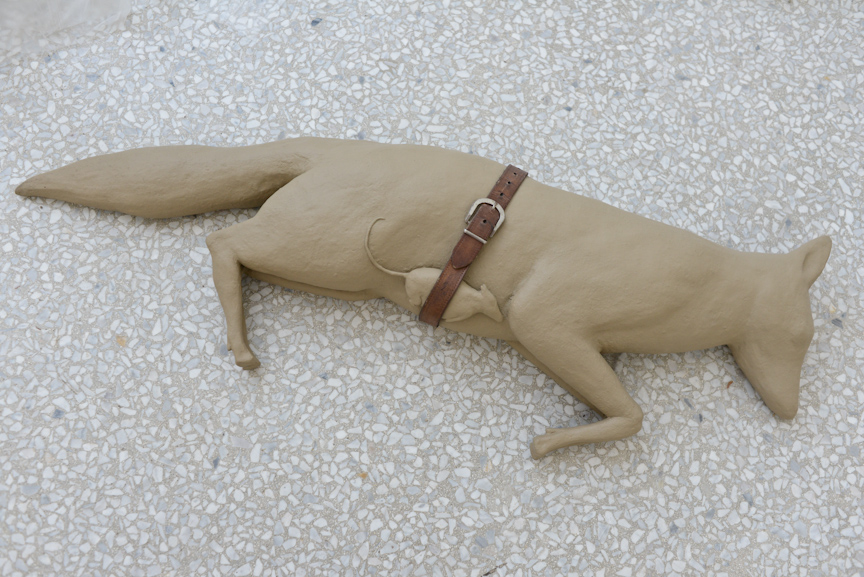The unfired clay figures in Mark Mander’s Room with Broken Sentence are actually painted epoxy or painted bronze. There are ceramic elements in his installation at the Dutch Pavilion (June 1 – November 24, 2013) at the 2013 Venice Biennale, but don’t trust your eyes, read the materials lists. The exhibition contains 23 years worth of Manders’ activity: installations, sculptures, offset prints on paper, architectural interventions; none of which can be taken at face value. Manders isn’t interested in prompting double takes or even questioning or destabilizing our assumptions that allow us to be in the world without melting down from over-stimulation; it’s much more complicated and lyrical than that.
Consider what Manders wrote about his bronze sculpture, Fox / Mouse / Belt, (pictured above) from 1992:
Actually, this work originated from a series of three separate words. The word “fox” consists of a jumping fox that I froze in the middle of a leap. I caught it at a moment in time. I then used my belt to tie a mouse to the fox’s stomach, into which the mouse would normally disappear. With a simple gesture, I took this “unit,” which took place in mid-air, and set it down on the ground, whereby the sculpture sank even deeper into motionlessness. Consequently, the moment seems to occur in a continuous present or outside of time. The stylization creates an unbelievable standstill without a “before” or “after.” During this period, I was also fascinated by the fact that living creatures can disappear into other creatures as food, sometimes even when they’re still alive. At the same time, I wanted to create a sculpture in which a human act could be clearly distinguished. I ended up painting the sculpture to look like it was made of wet clay. For this reason, it exhibits an extreme, vulnerable nakedness, and it seems as if you could just press your fingers into it at any time. This is the only future moment that the sculpture seems to capture.
The complexity of Fox / Mouse / Belt is just a taste of what Room with Broken Sentence holds. The installation is a coherent work that engages with the Dutch Pavilion itself, it’s more than a chronological retrospective because each of Manders’ works so precisely distills the subjects that he circles and also because he is deeply invested in ideas about architecture. In 1986, Manders started on the path to his mature work with a piece entitled Self-Portrait as a Building; it was a floor plan of a building in pen and ink. From this point on, his art has metaphorically and, at times, more literally been an exploration of an inner building.
Manders must not have been able to believe his luck when he learned that he would be working with the Dutch Pavilion, a modernist masterpiece by the great Dutch architect Gerrit Rietveld. (The building is coincidentally celebrating its 60th anniversary.) His preoccupation with time and architecture could be explored seamlessly. Many of the sculptures are part figure, part structure. Indeed, wooden slats that seem to reference pallets rather than virgin lumber frequently divide the faux clay figures, physically and metaphorically. Like the animals in Fox / Mouse / Belt, the human figures seem to be made of wet clay and thus elicit the unset, precarious nature of unfired clay. Art critic Melissa Gronlund called Manders’ figures “kouros-like,” and they do have an androgynous, timeless feel but also emit a heavy Neoclassical vibe. Every period of Neoclassicism has been fraught with a “turn back the clock” ethos, an anachronistic concept that Manders may very well be toying with.
Mark Mander (1968) was born in Volkel, the Netherlands and he lives and works in Arnhem, the Netherlands and Ronse, Belgium. Mark Manders: Parallel Occurrences/Documented Assignments was co-organized by Aspen Art Museum and the Hammer Museum, Los Angeles in 2010 and traveled to the Walker Art Center in Minneapolis, and was on view at the Dallas Museum of Art. The Absence of Mark Manders was organized by the Kunstverein Hanover, and traveled to Bergen Kunsthall; S.M.A.K. Ghent; and Kunsthaus Zurich from 2007-2009. Group exhibitions include, Walking in My Mind, The Hayward Gallery, London; The Quick and the Dead, Walker Art Center, Minneapolis; and Life on Mars, 55th Carnegie International, Carnegie Museum of Art, Pittsburgh. Manders work can be found in the permanent collections of The Art Institute of Chicago; Museum of Contemporary Art, Chicago; Carnegie Museum of Art, Pittsburgh; Kunsthaus Zurich; Museum of Modern Art, New York; Museum of Contemporary Art, Los Angeles; Art Gallery of Ontario, Toronto; Pinakothek der Moderne, Munich; S.M.A.K., Ghent; Stedelijk Museum, Amsterdam; and Walker Art Center, Minneapolis, among others.
Amy Albracht is the General Editor at CFile.
Above image: Mark Manders, Fox / Mouse / Belt, 1992. Painted bronze, belt. 15 x 120 x 40 cm. Courtesy of Zeno X Gallery and Tanya Bonakdar Gallery.

Installation view of Mark Mander’s Room with Broken Sentence in the Dutch Pavilion, Venice Biennale 2013.


Mark Manders, Working Table, 2012 – 2013, Painted epoxy, painted wood, painted canvas, iron, offset print on paper. 368 x 142 x 225 cm. Photograph by Jan Kempenaers.

Mark Manders, Mind Study, 2010 – 2011. Wood, painted ceramic, painted canvas, iron. 170 x 240 x 500 cm.

Installation view (detail) of Mark Mander’s Room with Broken Sentence in the Dutch Pavilion, Venice Biennale 2013.

Mark Manders, Shadow Study (2), 2010. Metal, porcelain, painted epoxy, and wood. 151 x 65 x 65 cm.

Mark Manders. Front: Shadow Study (2), 2010. Back: Window with Fake Newspapers, 2005-2013. Offset print on paper, cellotape. All images courtesy of the artist, Zeno X Gallery, and Tanya Bonakdar Gallery
Mark Manders: Room with Broken Sentence at the Dutch Pavilion, Venice Art Biennale 2013. Video by Heinrich Schmidt for Vernissage TV.
Visit the 2013 Venice Biennale

Add your valued opinion to this post.